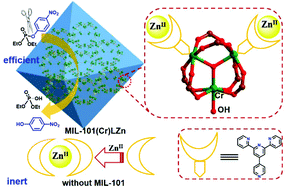MIL-101(Cr) with incorporated polypyridine zinc complexes for efficient degradation of a nerve agent simulant: spatial isolation of active sites promoting catalysis†
Abstract
Development of an efficient catalyst for degradation of organophosphorus toxicants is highly desirable. Herein, an MIL-101(Cr)LZn catalyst was fabricated by incorporating polypyridine zinc complexes into a MOF to achieve the spatial isolation of active sites. Compared with a terpyridine zinc complex without an MIL-101 support, this catalyst was highly active for detoxification of diethyl-4-nitrophenylphosphate.



 Please wait while we load your content...
Please wait while we load your content...